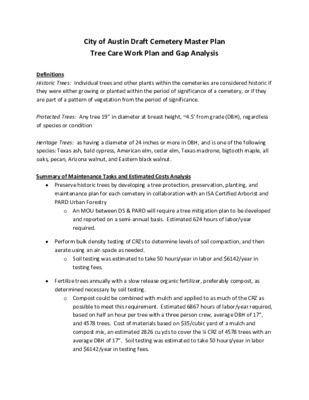F2 - Cemetery Master Plan Tree Care Service Analysis1 — original pdf
Backup

City of Austin Draft Cemetery Master Plan Tree Care Work Plan and Gap Analysis Definitions Historic Trees: Individual trees and other plants within the cemeteries are considered historic if they were either growing or planted within the period of significance of a cemetery, or if they are part of a pattern of vegetation from the period of significance. Protected Trees: Any tree 19” in diameter at breast height, ~4.5’ from grade (DBH), regardless of species or condition Heritage Trees: as having a diameter of 24 inches or more in DBH, and is one of the following species: Texas ash, bald cypress, American elm, cedar elm, Texas madrone, bigtooth maple, all oaks, pecan, Arizona walnut, and Eastern black walnut. Summary of Maintenance Tasks and Estimated Costs Analysis • Preserve historic trees by developing a tree protection, preservation, planting, and maintenance plan for each cemetery in collaboration with an ISA Certified Arborist and PARD Urban Forestry o An MOU between DS & PARD will require a tree mitigation plan to be developed and reported on a semi-annual basis. Estimated 624 hours of labor/year required. • Perform bulk density testing of CRZs to determine levels of soil compaction, and then aerate using an air-spade as needed. o Soil testing was estimated to take 50 hours/year in labor and $6142/year in testing fees. • Fertilize trees annually with a slow release organic fertilizer, preferably compost, as determined necessary by soil testing. o Compost could be combined with mulch and applied to as much of the CRZ as possible to meet this requirement. Estimated 6867 hours of labor/year required, based on half an hour per tree with a three person crew, average DBH of 17”, and 4578 trees. Cost of materials based on $35/cubic yard of a mulch and compost mix, an estimated 2826 cu yds to cover the ¼ CRZ of 4578 trees with an average DBH of 17”. Soil testing was estimated to take 50 hours/year in labor and $6142/year in testing fees. • Mulch all trees, covering as much of the Critical Root Zone (CRZ) as possible, while keeping a mulch free area around trunks o Compost could be combined with mulch and applied to as much of the CRZ as possible to meet this requirement. Estimated 6867 hours of labor/year required. Cost of materials based on $35/cubic yard of a mulch and compost mix, an estimated 2826 cu yds. to cover the ¼ CRZ of 4578 trees with an average DBH of 17”. Soil testing was estimated to take 50 hours/year in labor and $6142/year in testing fees. • Prune trees to remove dead, broken or diseased wood according to three priority levels: o 1st: Safety pruning including dead branches ≥4” in diameter, broken branches, etc. Cost estimate based on 225 hours of inspection time, and $285,763 in contract cost for pruning (estimated from previous years). o 2nd: Prune for heath and structure. Cost based on 2277 hours of labor using in-house crews. o 3rd: Prune for aesthetics. Cost based on 2277 hours of labor using in-house crews. This work would more than likely be captured by structural pruning, so may not be necessary as a stand-alone service. • Maintain historic trees, and explore all options for mitigating risk before removal, including cabling, bracing, and propping. o If this were included in the inspection process, it would increase the inspection time by an estimated 5 hours per tree. Estimating 3% of cemetery tree considered for removal per year, there would be 137 trees considered for these options, so an additional 685 hours of labor. Installation of these mitigation options would require yearly inspections and maintenance. This is estimated to require ~1 hour per tree per year. If one quarter of all removals were mitigated through cabling, bracing, or propping, this would be an additional 34 hours per year. So an additional 719 hours of inspection time would be required per year. The cost of installation is estimated at $500 per tree. • Inspect cemetery trees after large storms to look for tree damage, and prune as necessary. o Cost estimate based on performing a level 1 inspection of the cemetery trees, and an average of 1% of tree population damaged by a storm event, with an average of 3 damaging storms per year. Estimated number of trees scheduled for maintenance due to storm damage is expected to be higher than current level of service provided due to more thorough inspections of all cemeteries. • Prune trees only as necessary to reduce risk or improve tree health using the following prioritization levels: o 1st Priority – prune for safety (Level 1) o 2nd Priority – prune to preserve health of the tree including improving structure (Level 2) o 3rd Priority – Prune for aesthetics. Special Note: Topping of crape myrtles shall not be performed. (Level 3) See back for funding level summary. Summary of Estimated Levels of FundingItemHoursAdditional CostsRateCurrent Level of FundingRequired Level of FundingFunding GapTree protection/site plan review62430.53$ 1,588.00$ 19,051.00$ 17,463.00$ Soil Testing - nutrients and bulk density506,142.00$ 30.53$ -$ 7,668.50$ 7,668.50$ Composting & Mulching686798,910.00$ 91.23$ -$ 725,386.41$ 725,386.41$ Level 1 inspection & maintenance225285,763.00$ 28.66$ 50,000.00$ 292,211.50$ 242,211.50$ Level 2 pruning2277131.23$ -$ 298,810.71$ 298,810.71$ Level 3 pruning2277131.23$ -$ 298,810.71$ 298,810.71$ Cabling/Bracing/Propping inspection time71928.66$ -$ 20,606.54$ 20,606.54$ Cabling/Bracing/Propping installation costN/A17,000.00$ N/A-$ 17,000.00$ 17,000.00$ Inspection following storms22528.66$ -$ 6,448.50$ 6,448.50$ Maintenance following storms138131.23$ 5,511.66$ 18,109.74$ 12,598.08$ Totals57,099.66$ 1,704,103.61$ 1,647,003.95$